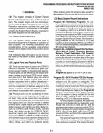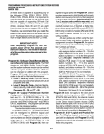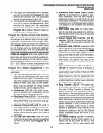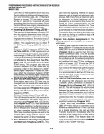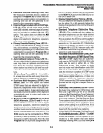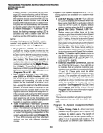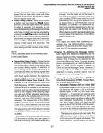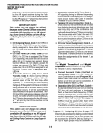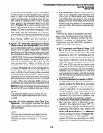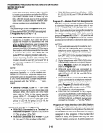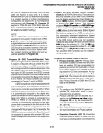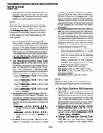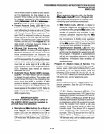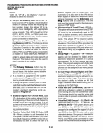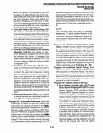
SECTION 100-816-302
MARCH 1993
busy tone. The CO line can be disconnected
by the AR signal anytime during the “talk
state” of a call. If a CO line is disconnected
by the AR signal, a
‘I*” will print by the CO line
number on the SMDR report.
IMPORTANT NOTE!
This option can not always be utilized
because some Central Offices may send
unreliable AR signaling or no AR signal-
ing. Some Central Offices call the AR sig-
nal Calling Party Control or Loop Supervi-
sion.
CO Outgoing Signal, Code 1 (for STRATA
DK16 only)-Each CO line can be indepen-
dently assigned to have either Dial Pulse
(DP) or Dual-tone Multi-frequency (DTMF)
signaling.
CO Dial Pulse (DP) Rate, Code 2-On
DK16, if a CO line is assigned Dial Pulse
(DP) signaling, the pulse rate can be set at
either 20 or IO pulses per second. Some
Central Offices do not reliably accept 20
pulses per second. On DK8, CO line dial
pulse rate (10 or 20 PPS) is assigned for all
CO lines, system wide, in Program IO-I,
LED 14.
Automatic Release (AR) From Hold/
Transfer, Code 3-Some Central Offices
will send the AR signal-a 95 or 450-milli-
second open of the CO line loop-after
(typically 1 - 15 seconds) an external party
hangs up. If the system CO line is on hold (or
being transferred to another station) when
this signal occurs, it will be automatically
disconnected if this option is activated. Two-
CO line DISA calls always release when AR
is sent, no matter what the Code 3 setting is.
If a CO line is disconnected by the AR signal,
a
“*” will print by the CO line number on the
SMDR report.
IMPORTANT NOTE!
This option can not always be utilized
because some Central Offices may send
unreliable AR signaling or no AR signal-
ing. Some Central Offices call the AR sig-
nal Calling Party Control or Loop Supervi-
sion.
l
Automatic Release (AR) Time, Code 4-
AR signaling timing is different depending
on the Central Office equipment. An assign-
ment choice exists with Code 4 between
Crossbar or ESS Central Offices.
l
Tandem CO Line Connection, Code 5-
Once a two CO line conference call is made
by a digital or electronic telephone user, that
user may drop out of the conference and
optionally leave the two CO lines connected.
The choice exists with Code 5 for each CO
line that may have this capability. This op-
tion must be enabled to allow CO lines to be
used for outgoing DISA calls.
l
CO Line Tenant Assignment, Code 6-A
system may be effectively split into two parts
in order to serve two tenants using the same
system in a shared arrangement. This as-
signment dedicates CO lines to one tenant
or the other. If tenant service is not desired,
leave the assignments all for tenant 1, as
initialized.
NOTE:
The Night Transfer1 and Night
Transfer2 buttons control CO ring modes
for Tenants I and 2, respectively.
l
Forced Account Code (Verified or
Nonverified), Code 7-If the Forced Ac-
count Code feature is used (Program 30) a
station user must enter an Account Code
before a CO line call can be completed. A
choice exists for each CO line.
l
Operation After CO Line Flash, Code 8-
If a standard telephone user is on an existing
CO line call and performs a hookswitch
flash, a Dual-tone Multi-frequency (DTMF)
receiver channel may or may not be con-
nected, depending on this assignment. If the
CO is a rotary dial only type, the QRCU or
K4RCU must be seized after flash when
dialing from DTMF standard telephones.
The QRCU or K4RCU will decode the dialed
tones and send dial pulses to the CO line.
Program 16-Assigning CO Line Groups: CO
lines may be accessed by dialing a code instead
of with a CO line button. Up to four groups may
be accessed for STRATA DK8 by dialing 81 -
84. Up to eight groups may be accessed for
2-8




